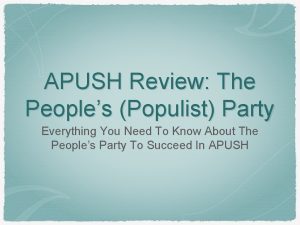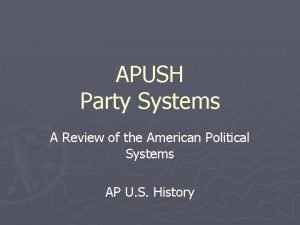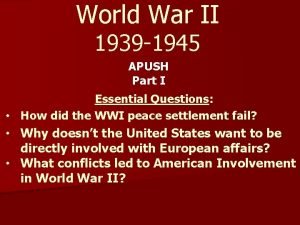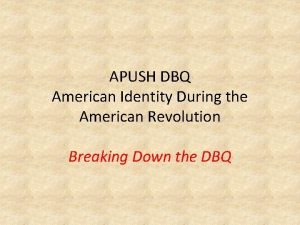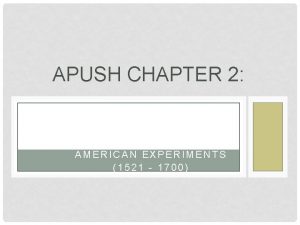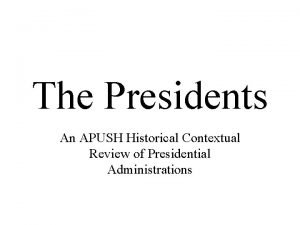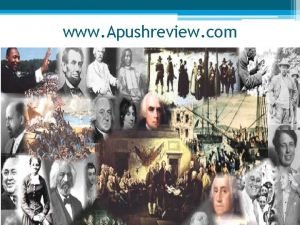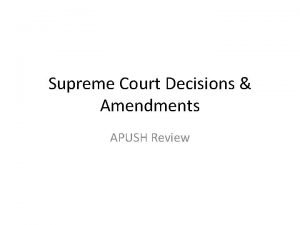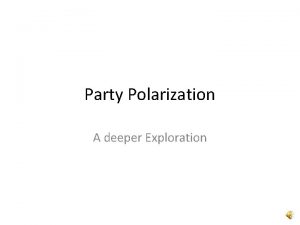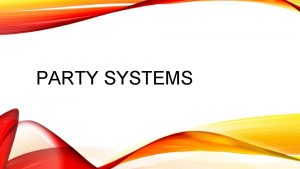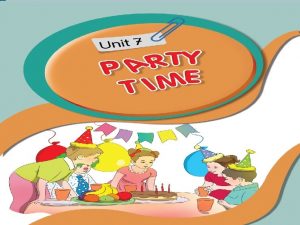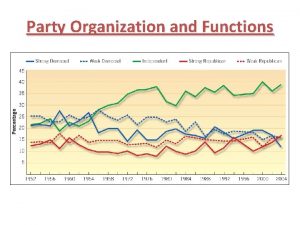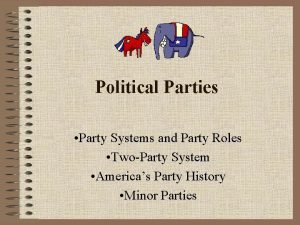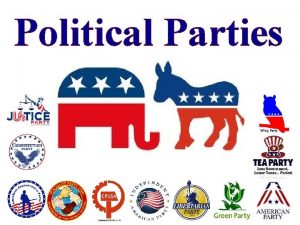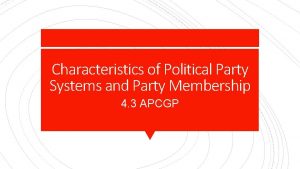APUSH Party Systems A Review of the American



































- Slides: 35

APUSH Party Systems A Review of the American Political Systems AP U. S. History

FIRST PARTY SYSTEM 1789 – 1824 Major Issues and Characteristics ► Scope and Power of the Federal Government § Virginia and Kentucky Resolutions § Marbury v. Madison (1803) ► Hamilton Economic Plans § § § ► ► ► Bank of the United States (BUS) Tariffs Excise taxes French Revolution § Alien and Sedition Acts Louisiana Purchase ► War of 1812 ► ► Dominated primarily by foreign policy issues until after War of 1812 Party caucuses chose presidential nominees Limited electorate –property requirements for voting No traditional party loyalties to build support Network of newspapers Federal Government Dominance § § § ► Federalist dominance from 1789 to 1800 Democratic-Republican dominance of Congress and White House from 1800 to 1824 Federalist dominance of Federal Judiciary 1789 to 1833 Era of Good Feelings (1816 -1824) § D-R virtually only national party

FIRST PARTY SYSTEM 1789 – 1824 Major Party Comparison Federalists ► ► ► ► Strong central government Broad interpretation of the Constitution/implied powers Hamilton economic plans Banking, commerce, manufacturing Party of order and good government New England Alexander Hamilton, John Adams, John Marshall Appealed to elites Democratic-Republicans aka Republicans ► ► ► ► States’ rights and weak central government Strict constructionists Agriculture (planters, farmers) Party of individual liberties, republicanism, popular democracy South and Mid-Atlantic Thomas Jefferson, James Madison, Albert Gallatin Appealed to a broader popular base

FIRST PARTY SYSTEM 1789 – 1824 Turning Point ►REALIGNMENT Election of 1800 ► Democratic-Republicans won majorities in Congress ► Jefferson won the White House

FIRST PARTY SYSTEM 1789 – 1824 Turning Point ► War of 1812 Dem-Rep War Hawks ► Federalists opposed the war ► Hartford Convention (1814) ► § Federalist talk of secession ► Federalist Party viewed as traitorous and weakened as a national party

FIRST PARTY SYSTEM 1789 – 1824 Presidents ► George Washington (1789 -1797) –Non-Partisan* § * - leaned toward Federalist policies ► John Adams (1797 -1801) –Federalist ► Thomas Jefferson (1801 -1809) –Democratic. Republican ► James Madison (1809 -1817) – Democratic-Republican ► James Monroe (1817 -1825) – Democratic-Republican

SECOND PARTY SYSTEM 1824 - 1860 Turning Point ► REALIGNMENT Election of 1824 ► Democratic-Republicans split into factions § Old Guard to preserve Jeffersonian principles § Some D-R’s adopt Federalist/Hamiltonian-type policies ► “Corrupt Bargain” § Inspires Jackson Democrats

SECOND PARTY SYSTEM 1824 – 1860 Major Issues and Characteristics Bank War ► Nullification Crisis ► Manifest Destiny ► § Oregon Territory § Mexican-American War ► Sectionalism and Slavery § § Abolitionism Compromise of 1850 Kansas-Nebraska Act (1854) Dred Scott case (1857) ► ► Universal male suffrage Mass-based party organization and popular campaign styles § § National conventions Campaign rallies and slogans ► “Tippecanoe and Tyler Too” § ► ► Two-party system spread to all regions and states; not overwhelmingly dominated by one party Party loyalty § § ► ► ► Spoils system Straight ticket voting at all political levels Rise of professional politicians Minor Parties § § ► National network of newspapers Liberty Party Free Soil Party Know Nothing Party Anti-Masonic Party Highly competitive elections Democrats particularly dominant in 1850 s

SECOND PARTY SYSTEM 1824 - 1860 Major Party Comparison National Republicans/Whigs ► American System § § § ► Ambivalent and split on slavery § ► ► ► National bank Infrastructure Protective tariffs Conscience Whigs and Cotton Whigs Advocated internal development A powerful legislative branch/Congress Party of modernity Henry Clay, Daniel Webster Appealed to modernizers, industrialists, businessmen, bankers, commercial farmers, Protestant evangelists Democrats ► ► ► ► States’ rights Low tariffs Slave Power Advocated western expansion A powerful executive branch/President Party of Jefferson and tradition Andrew Jackson, James K. Polk Appealed to planters, yeoman farmers, artisans, working class, immigrants, Catholics

SECOND PARTY SYSTEM 1824 - 1860 Turning Point ►Kansas- Nebraska Act (1854) ► Whigs virtually ended as a national party ► Helps to build a coalition of Anti-slave Democrats, Conscience Whigs, Free Soilers, and abolitionists

SECOND PARTY SYSTEM 1824 1860 – Presidents John Quincy Adams (1789 -1797) –National Republican ► Andrew Jackson (1797 -1801) –Democrat ► Martin van Buren (1837 -1841) – Democrat ► William Henry Harrison (1841) –Whig ► John Tyler (1841 -1845) – Whig* ► § * - kicked out by Whig party for Democrat leaning policies James K. Polk (1845 -1849) –Democrat ► Zachary Taylor (1849 -1850) –Whig ► Millard Fillmore (1850 -1853) – Whig ► Franklin Pierce (1853 -1857) –Democrat ► James Buchanan (1857 -1861) – Democrat ►

THIRD PARTY SYSTEM 1860 - 1896 Turning Point ►REALIGNMENT Election of 1860 ► Ascendance of the Republican Party

THIRD PARTY SYSTEM 1860 - 1896 Major Issues and Characteristics ► Civil War ► ► ► Reconstruction ► ► Compromise of 1877 ► Gilded Age Industrialization ► Civil Service Reform ► ► Tariffs ► Panic of 1893 ► ► ► Political Party Machines/Boss Politics Extremely competitive elections High voter turnout rates Mass-based party organization and popular campaign styles § § National conventions Campaign rallies and slogans ► “waving the bloody shirt” § National network of newspapers Party loyalty § § Spoils system Straight ticket voting at all political levels Republicans dominated White House and Senate Democrats tended to control the House of Representatives after 1877 Civil War and Reconstruction dominated from 1860 to 1877 Tariffs and business expansion dominated from 1865 to 1896 Both parties encouraged pro-business expansion

THIRD PARTY SYSTEM 1860 - 1896 Major Party Comparison Republicans (GOP) ► National policies § § § ► ► Hard money policies/gold standard Northeast Pietistic denominations and sects (Methodists, Congregationalists) Split over civil service reform § § § ► Homestead Act Land grants and infrastructure (railroads) Protective tariffs Stalwarts –supported patronage Half-breeds – civil service reform Mugwumps – frustrated with GOP corruption Appealed to businessmen, industrialists, professionals, scalawags, carpetbaggers, blacks/freedmen Democrats ► ► ► ► Laissez-faire policies Low tariffs Solid South Liturgical denominations and sects (Catholics) Bourbon Democrats –pro-business Democrats Redeemer Democrats – Southern Democrats return to power in Solid South Appealed to traditional laissez-faire Democrats, small farmers, unskilled labor, urban immigrants

THIRD PARTY SYSTEM 1860 - 1896 Turning Point ►Civil War Southern states seceding weakened Solid South faction of Democrats in Congress ► Republicans dominated federal government from 1860 to 1877 ► § Thirteenth Amendment, Fourteenth Amendment, Fifteenth Amendment § Radical Reconstruction

THIRD PARTY SYSTEM 1860 - 1896 Turning Point ► Compromise 1877 of Election of 1876 controversy ► Federal troops withdrawn from South ► Reconstruction ends ► Redeemer Democrats return to power in South ► § Leads to Jim Crow laws

THIRD PARTY SYSTEM 1860 1896 – Presidents Abraham Lincoln (1861 -1865) –Republican ► Andrew Johnson (1865 -1869) –Democrat* ► § * Joined Lincoln as party of Union party during Civil War Ulysses S. Grant (1869 -1877) –Republican ► Rutherford B. Hayes (1877 -1881) – Republican ► James Garfield (1881) – Republican ► Chester A. Arthur (1881 -1885) – Republican ► Grover Cleveland (1885 -1889) –Democrat ► Benjamin Harrison (1889 -1893) –Republican ► Grover Cleveland (1893 -1897) –Democrat ►

FOURTH PARTY SYSTEM 1896 - 1932 Turning Point ►REALIGNMENT Election of 1896 Corporate Business of Mc. Kinley vs. Populism of William Jennings Bryan ► Republican campaign tactics ► § Campaign donations from big business and wealthy elites ► Democrat campaign tactics § Cross-country tours § Stump speeches

FOURTH PARTY SYSTEM 1896 - 1932 Major Issues and Characteristics ► Imperialism § Spanish-American War Progressive Era Reforms (1900 -1920) ► Prohibition ► Women’s suffrage ► Roaring Twenties ► World War I/League of Nations ► Great Depression ► ► Foundation for developing welfare state and increased government intervention § ► Weakening of Patronage and Boss Politics § § § ► ► ► GOP dominant in Northeast Democrat Solid South Relatively lower voter turnout Virtually dominated by the Republican Party § ► Civil Service Reform Australian/secret ballot Direct Primary elections Scientific management applied to local/state government; non-partisan local elections City manager system Both parties assumed more centrist positions and approaches Return of one-party dominated states § § ► New Nationalism and New Freedom Woodrow Wilson (D) wins White House primarily of GOP split in Election of 1912 Conservative Republicans emphasized pro-business and laissez-faire policies during 1920 s

FOURTH PARTY SYSTEM 1896 - 1932 Major Party Comparison Republicans (GOP) ► ► ► Party of big business and laissezfaire economic policies Progressive Republicans William Mc. Kinley, Mark Hanna, Theodore Roosevelt, Robert La. Follette, Calvin Coolidge, Herbert Hoover Appealed to businessmen, corporations, Advocated pro-imperialist policies Supported Prohibition Democrats ► ► ► Assumed Populist and progressive agendas Woodrow Wilson, William Jennings Bryan, Benjamin Tillman Appealed to western farmers, immigrants, Catholics, urban Tended to be anti-imperialist While mixed on Prohibition, eventually assumed anti. Prohibition prior to 1932

FOURTH PARTY SYSTEM 1896 - 1932 Turning Point ►Assassination of William Mc. Kinley (1901) ► Results in Theodore Roosevelt ascension to presidency ► Launches Progressive reforms at federal level

FOURTH PARTY SYSTEM 1896 - 1932 Turning Point ►Crash of 1929 ► Americans blamed GOP policies and Herbert Hoover ► Led to default victory of FDR and Democrats in Election of 1932

FOURTH PARTY SYSTEM 1896 1932 – Presidents ► William Mc. Kinley (1897 -1901) –Republican ► Theodore Roosevelt (1901 -1909) – Republican ► William Howard Taft (1909 -1913) – Republican ► Woodrow Wilson (1913 -1921) –Democrat ► Warren G. Harding (1921 -1923) –Republican ► Calvin Coolidge (1923 -1929) – Republican ► Herbert Hoover (1929 -1933) - Republican

FIFTH PARTY SYSTEM 1932 - 1968 Turning Point ►REALIGNMENT Election of 1932 ► Great Depression blame on Republicans ► Democratic majorities in Congress ► Franklin D. Roosevelt wins White House ► New Deal Coalition

FIFTH PARTY SYSTEM 1932 - 1968 Major Issues and Characteristics New Deal ► World War II ► Cold War ► Korean War ► Civil Rights Movements ► Great Society ► Vietnam ► ► ► Major shift toward liberal policies and increased federal government intervention in American society; establishment of American welfare state Development of New Deal Coalition Democrat dominance in the White House and Congress Republicans on the brink of collapse from 1940 s to early 1960 s § Eisenhower preserved New Deal policies ► Candidate-centered campaigning § § Radio –Fireside chats Television – commercials, debates

FIFTH PARTY SYSTEM 1932 - 1968 Major Party Comparison Republicans (GOP) ► Economic conservatism and laissez-faire policies ► Robert Taft, Barry Goldwater; Dwight D. Eisenhower, Nelson Rockefeller, Richard Nixon ► Regional bases in Northeast and Midwest Democrats ► New Deal Coalition § Blacks, intellectuals, progressives, urban party machines, immigrants, labor unions and working class, lower class, Southern conservatives, populist farmers, Catholics Franklin D. Roosevelt, Harry S. Truman, John F. Kennedy, Lyndon B. Johnson ► Dominant in South ► Democrat assumption of civil rights disgruntled Southern Democrats aka Dixiecrats ►

FIFTH PARTY SYSTEM 1932 - 1968 Turning Point ►Election of 1948 ► Dixiecrats led by Strom Thurmond disgruntled with Democratic Party § New Deal increasing federal government intervention § Democrats assuming civil rights initiatives

FIFTH PARTY SYSTEM 1932 1968 – Presidents ► Franklin D. Roosevelt (1933 -1945) –Democrat ► Harry S. Truman (1945 -1953) – Democrat ► Dwight D. Eisenhower (1953 -1961) –Republican ► John F. Kennedy (1961 -1963) –Democrat ► Lyndon B. Johnson (1963 -1969) - Democrat

SIXTH PARTY SYSTEM 1968 - Present Turning Point ►REALIGNMENT Election of 1968 Nixon’s “Law and Order” and Southern Strategy ► George Wallace and American Independent Party signal end of Democrat dominance in Southeast ► Nixon will initiate New Federalism, devolution ►

SIXTH PARTY SYSTEM 1968 - Present Major Issues and Characteristics Vietnam ► Cold War ► Civil Rights Movements ► Stagflation ► ► Roe v. Wade Globalization ► War on Terror ► ► ► ► ► Frequent divided governments Increased role of Independents Split-ticket voting Party primaries nominate presidential candidates Center-right approach to public policy Increased role of Christian conservatives in politics ”Solid South” aligns with Republican Party Emergence of gender gap

SIXTH PARTY SYSTEM 1968 - Present Major Party Comparison Republicans (GOP) ► ► ► New Federalism; devolution Supply-side economics American exceptionalism Neoconservatism Midwest, Mountain, and Southeast/Bible Belt (formerly the Solid South), rural areas, suburbia Appealed to affluent middle and upper classes, corporates, working -class social conservatives, Christian conservatives Democrats Keynesian policies and social welfare programs ► Multinationalism ► New Democrats ► § Bill Clinton Northeast, Pacific coast, urban centers ► Appealed to urbanites, blacks, liberals, professionals ►

SIXTH PARTY SYSTEM 1968 - Present Turning Point ►Roe v. Wade ► Galvanized American Christian conservatives § Moral Majority and Jerry Falwell

SIXTH PARTY SYSTEM 1968 - Present Turning Point ►Election of 1980 ► Addition of Moral Majority/Christian Coalition to Republican base

SIXTH PARTY SYSTEM 1968 - Present Turning Point ►Mid-Term Elections of 1994 ► “Republican Revolution” ► Contract with America ► Ends Democratic dominance of Congress and state legislatures, especially in the South

SIXTH PARTY SYSTEM 1968 –Present Presidents ► Richard Nixon (1969 -1974) –Republican ► Gerald Ford (1974 -1977) – Republican ► Jimmy Carter (1977 -1981) –Democrat ► Ronald Reagan (1981 -1989) –Republican ► George H. W. Bush (1989 -1993) – Republican ► Bill Clinton (1993 -2001) –Democrat ► George W. Bush (2001 -2009) –Republican ► Barack Obama (2009 -2017) –Democrat ► Donald Trump (2017 -? ? ) - Republican
 Second party system apush definition
Second party system apush definition Fourth party logistics advantages and disadvantages
Fourth party logistics advantages and disadvantages Populists apush
Populists apush Fourth party system apush
Fourth party system apush Benito mussolini apush
Benito mussolini apush Battle of buena vista apush
Battle of buena vista apush American identity apush
American identity apush Clay's american system apush
Clay's american system apush Chapter 2 american experiments summary
Chapter 2 american experiments summary Hawley smoot tariff apush
Hawley smoot tariff apush Apush period 2
Apush period 2 Marbury vs madison significance apush
Marbury vs madison significance apush Apush supreme court cases
Apush supreme court cases Apush period 3 review
Apush period 3 review Apush unit 6 test
Apush unit 6 test Market revolution apush
Market revolution apush Taylorism apush
Taylorism apush Apush period 9 review
Apush period 9 review Sunbelt apush
Sunbelt apush Apush unit 2 review
Apush unit 2 review Apush review games
Apush review games Judicial review apush
Judicial review apush Apushreview.com
Apushreview.com Apushreview
Apushreview Hát kết hợp bộ gõ cơ thể
Hát kết hợp bộ gõ cơ thể Lp html
Lp html Bổ thể
Bổ thể Tỉ lệ cơ thể trẻ em
Tỉ lệ cơ thể trẻ em Voi kéo gỗ như thế nào
Voi kéo gỗ như thế nào Tư thế worm breton
Tư thế worm breton Alleluia hat len nguoi oi
Alleluia hat len nguoi oi Môn thể thao bắt đầu bằng chữ f
Môn thể thao bắt đầu bằng chữ f Thế nào là hệ số cao nhất
Thế nào là hệ số cao nhất Các châu lục và đại dương trên thế giới
Các châu lục và đại dương trên thế giới Công của trọng lực
Công của trọng lực Trời xanh đây là của chúng ta thể thơ
Trời xanh đây là của chúng ta thể thơ


